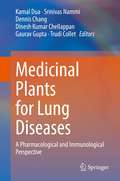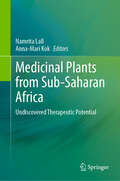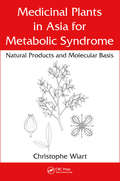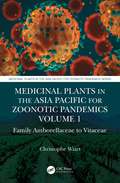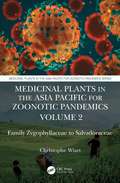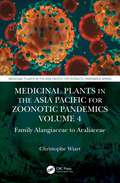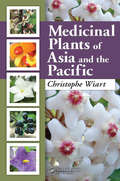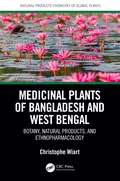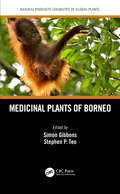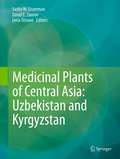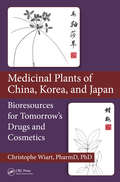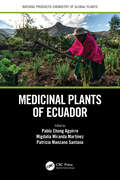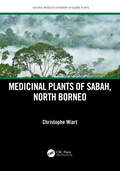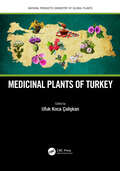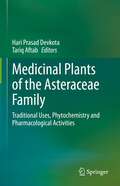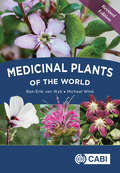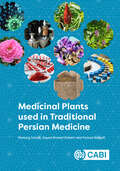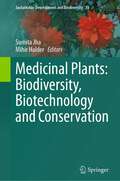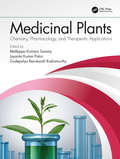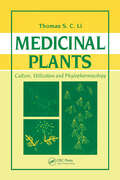- Table View
- List View
Medicinal Plants for Lung Diseases: A Pharmacological and Immunological Perspective
by Gaurav Gupta Kamal Dua Srinivas Nammi Dennis Chang Dinesh Kumar Chellappan Trudi ColletThis book summarizes experimentally-supported research on the therapeutic efficacy of plant extracts and their constituents on a range of respiratory diseases including infections. It discusses the pharmacological, cellular and molecular factors involved in the pathogenies of respiratory diseases and their modulation by plant-derived compounds. Additionally, it underlines the growing relevance of medicinal plant-based advanced drug delivery systems for treating lung diseases providing maximal therapeutic efficacy with better patient compliance. Overall, this comprehensive book is a blend of translational, biological, chemical and drug delivery aspects of medicinal plants employed in targeting respiratory diseases and attracts a range of audiences including physiochemist, translational and clinical researchers working in the field of respiratory diseases.
Medicinal Plants for the Management of Neurodegenerative Diseases (Exploring Medicinal Plants)
by Maryam Sarwat Jamal Akhtar Fouzia BashirAgeing is the main reason for most neurodegenerative diseases, including Alzheimer’s disease (AD) and Parkinson’s disease (PD). About 10% of individuals aged ≥65 years develop AD, which continuously increases with growing age. Medicinal plants have been used for age-related neurodegenerative disorders for a long time. These plants are rich in terms of various phytochemical constituents such as flavonoids, sterols, alkaloids, saponins, and terpenoids. Different scientific studies have been carried out on these medicinal herbs, e.g., anti-inflammatory, antioxidant, and neuro-regenerative activities that may be used in the treatment of AD and other age-related diseases. These medicinal plants, e.g., Curcuma longa, Bacopa monniera, Glycyrrhiza glabra, Commiphora whighitti, and Acorus calamus L., have anti-inflammatory properties that may decrease swelling of the brain tissue in AD.Despite this, there is currently no book available in the market that provides full information on the phytochemical and medicinal uses of the medicinal plants exclusively used for the management of neurodegenerative diseases in the elderly. This book aims to provide some important and evidence-based information on the plants used for neurodegenerative diseases in the elderly, especially AD and PD, in a planned manner so the academicians, researchers, and students working in the fields of medicinal plants, plant science, chemistry, biotechnology, pharmacognosy, pharmaceuticals, biochemistry, and many other interdisciplinary subjects may benefit. This book will also be useful in identifying a few medicinal plants and their prospects for the synthesis or preparation of new drugs for neurodegenerative diseases.Features: An overview of the medicinal plants that can be helpful for neurodegenerative disorders Recent research results and some pointers for the management of neurodegenerative diseases This book serve as comprehensive information about the description, phytochemistry, actions, and medicinal use of plants that are used in neurodegenerative diseases. In addition, this book will also ease the understanding and interaction of medicinal plants used in neurodegenerative diseases.
Medicinal Plants from Sub-Saharan Africa: Undiscovered Therapeutic Potential
by Namrita Lall Anna-Mari KokSouth Africa boasts high biodiversity among its flora and this is associated with many undiscovered medicinal plants with therapeutic potential. To target this untapped resource, the first step is to introduce these species to a wider spectrum of audience, be they the academics who carry out research, students interested in holistic medicine and healing, or those working in the natural product industry. In this work, we document a list of medicinal plants from Sub-Saharan Africa that have been underestimated in their therapeutic value and not thoroughly studied. Our book contains the recent scientific studies and validation on the individual plants. Written and organised in an easily accessible way, each entry includes specific information on the plant’s distribution, traditional usage and their phytochemical content. In summary, this book introduces new and exciting plants of Sub-Saharan Africa in a comprehensive and well-thought-out format for academia, pharmacists, clinicians, complementary and alternative medicine practitioners, traditional healers, industry and the general experienced or novice botanist.
Medicinal Plants in Asia for Metabolic Syndrome: Natural Products and Molecular Basis
by Christophe WiartMedicinal Plants in Asia for Metabolic Syndrome: Natural Products and Molecular Basis offers an in-depth view into the metabolic syndrome pharmacology of natural products with an emphasis on their molecular basis, cellular pathways, metabolic organs, and endocrine regulations. This sensational volume provides the scientific names, botanical classifications, botanical descriptions, medicinal uses, chemical constituents, and pharmacological activities of more than 100 Asian plants, with high quality original botanical plates, chemical structures, and pharmacological diagrams. It also lists hundreds of carefully selected bibliographical references, constituents on insulin resistance, obesity, atherosclerosis, atherogenic dyslipidemia, and endothelial dysfunction.
Medicinal Plants in the Asia Pacific for Zoonotic Pandemics, Volume 1: Family Amborellaceae to Vitaceae (Medicinal Plants in the Asia Pacific for Zoonotic Pandemics #1)
by Christophe WiartMedicinal Plants in the Asia Pacific for Zoonotic Pandemics provides an unprecedented, comprehensive overview of the phylogeny, botany, ethnopharmacology, and pharmacology of more than 100 plants used in the traditional medical systems of Asia and Pacific. It discusses their actions and potentials against viruses, bacteria, and fungi that represent a threat of epidemic and pandemic diseases, with an emphasis on the molecular basis and cellular pathways. This book presents scientific names, the botanical classification, traditional medicinal uses, active chemical constituents, and pharmacology. This volume is a critical reference for anyone involved in the discovery of lead molecules or phytopharmaceutical products for the prevention or treatment of pandemic viral, bacterial, or fungal infections. FEATURES Phylogenetic presentation of medicinal plants and a chemotaxonomical rationale of antiviral, antibacterial, and antifungal actions Discusses the chemical structure–activity relationship, pharmacokinetics, and oral bioavailability of antimicrobial principles Introduces the molecular mechanism of natural products on viruses, bacteria, and fungi Contains a selection of botanical plates and useful bibliographic references This book is a useful research tool for postgraduates, academics, and the pharmaceutical, herbal, and nutrition industries. Medicinal Plants in the Asia Pacific for Zoonotic Pandemics includes commentary sections that invite further research and reflection on the fascinating and timely subject of the development of drugs and herbals from Asia-Pacific medicinal plants to safeguard humanity and other life forms against the forthcoming waves of viral, bacterial, or fungal pandemics. This book is an ideal reference text for medicinal plant enthusiasts.
Medicinal Plants in the Asia Pacific for Zoonotic Pandemics, Volume 2: Family Zygophyllaceae to Salvadoraceae (Medicinal Plants in the Asia Pacific for Zoonotic Pandemics)
by Christophe WiartMedicinal Plants in the Asia Pacific for Zoonotic Pandemics provides an unprecedented, comprehensive overview of the botany, ethnopharmacology, and pharmacology of more than 100 plants used in the traditional medical systems of Asia and Pacific medicine for the treatment of microbial infections. It discusses their actions and potentials against viruses, bacteria, and fungi that represent a threat of epidemic and pandemic diseases, with an emphasis on the molecular basis and cellular pathways. This book presents for each plant the botanical classification, synonyms, scientific names, local names, habitat, distribution, botanical description, traditional medicinal uses, antimicrobial activities, active antimicrobial principles, and commentaries. This volume is a critical reference for anyone involved in the development of lead molecules or phytopharmaceutical products for the prevention or treatment of pandemic viral, bacterial, or fungal infections. FEATURES Includes phylogenetic presentations of medicinal plants and a chemotaxonomical rationale of antiviral, antibacterial, and antifungal actions Discusses the chemical structure–activity relationship, pharmacokinetics, and oral bioavailability of antimicrobial principles Introduces the molecular mechanism of natural products on viruses, bacteria, and fungi Contains a selection of handmade botanical plates and useful bibliographic references This book is a useful research tool for postgraduates, academics, and the pharmaceutical, herbal, and nutrition industries. Medicinal Plants in the Asia Pacific for Zoonotic Pandemics includes commentary sections that invite further research and reflection on the fascinating and timely subject of the development of leads or herbals from Asia-Pacific medicinal plants to safeguard humanity against COVID-19 and the forthcoming waves of viral, bacterial, or fungal pandemics. This book is an ideal reference text for medicinal plant enthusiasts.
Medicinal Plants in the Asia Pacific for Zoonotic Pandemics, Volume 3: Family Bixaceae to Portulacaceae (Medicinal Plants in the Asia Pacific for Zoonotic Pandemics)
by Christophe WiartMedicinal Plants in the Asia Pacific for Zoonotic Pandemics provides an unprecedented, comprehensive overview of the phylogeny, botany, ethnopharmacology, and pharmacology of more than 100 plants used in the traditional systems of Asia and Pacific medicine for the treatment of microbial infections. It discusses their actions and potentials against viruses, bacteria, and fungi that represent a threat of epidemic and pandemic diseases, with an emphasis on the molecular basis and cellular pathways. This book presents for each plant the scientific name, the botanical classification, traditional medicinal uses, active chemical constituents, and pharmacology. This volume is a critical reference for anyone involved in the discovery of leads for the development of lead molecules or phytopharmaceutical products for the prevention or treatment of pandemic viral, bacterial, or fungal infections. FEATURES Includes phylogenetic presentation of medicinal plants and a chemotaxonomical rationale of antiviral, antibacterial, and antifungal actions Discusses chemical structure–activity relationship, pharmacokinetics, and oral bioavailability of antimicrobial principles Introduces the molecular mechanism of natural products on viruses, bacteria, and fungi Contains a selection of botanical plates and useful bibliographic references This book is a useful research tool for postgraduates, academics, and the pharmaceutical, herbal, and nutrition industries. Medicinal Plants in the Asia Pacific for Zoonotic Pandemics includes commentary sections that invite further research and reflection on the fascinating and timely subject of the development of leads or herbals from Asia-Pacific medicinal plants to safeguard humanity against the forthcoming waves of viral, bacterial, or fungal pandemics. This book is an ideal reference text for medicinal plant enthusiasts.
Medicinal Plants in the Asia Pacific for Zoonotic Pandemics, Volume 4: Family Cornaceae to Apiaceae (Medicinal Plants in the Asia Pacific for Zoonotic Pandemics #4)
by Christophe WiartViruses and plagues have constantly threatened the survival of humanity since the evolution of modern man. Medical advances, thanks to the application of remedial plants, have helped to fight back against some of the most nefarious bacterial and viral infections, giving humanity a fighting chance. This fourth volume in the Medicinal Plants in the Asia Pacific for Zoonotic Pandemics series provides an unprecedented, comprehensive overview of the pharmacological activity of more than 100 medicinal plants used for the treatment of microbial infections in Asia and the Pacific. The text discusses the actions of such plants against viruses and bacteria representing a threat of epidemic and pandemic diseases, including COVID-19, with an emphasis on the molecular basis and cellular pathways. Scientific names, botanical classifications and descriptions, medicinal uses, and chemical constituents are presented, along with chemical structures and a vast selection of bibliographical references. FEATURES Introduces the molecular mechanism of natural products from medicinal plants in Asia on bacteria and viruses Includes phylogenetic presentations of a selection of medicinal plants and a chemotaxonomical rationale of antiviral and antibacterial actions Discusses the chemical structure–activity relationship, pharmacokinetics, and bioavailability of antimicrobial principles This book is a useful research tool for postgraduates, academics, and the pharmaceutical, herbal, and nutrition industries looking forward to developing antiviral and antibacterial agents from medicinal plants in Asia. Medicinal Plants in the Asia Pacific for Zoonotic Pandemics is a critical reference for anyone involved in the discovery of leads for the treatment of pandemic viral, bacterial, and infections. "This book will be an important resource for scientists, as well as people passionate about helping to save these critical resources. Perhaps a new drug lead will be identified from at least one of these plants." —From the Foreword by Dr. Mark S. Butler, MSBChem Consulting, Brisbane, Australia
Medicinal Plants of Asia and the Pacific
by Christophe WiartDrawing on the author's extensive personal experience, Medicinal Plants of Asia and the Pacific provides comprehensive coverage of the medicinal plants of the region. Describing more than 300 compounds, the book discusses every important class of natural products while highlighting cutting-edge research and recent developments. With its broa
Medicinal Plants of Bangladesh and West Bengal: Botany, Natural Products, & Ethnopharmacology (Natural Products Chemistry of Global Plants)
by Christophe WiartMedicinal Spices of Bengal is a complete compendium. It provides the scientific name, classification, local name(s), historical background, local medicinal uses, botanical description, chemical constituents, pharmacological activity and toxicology of more than 100 medicinal spices used in Bengal. Chemical structures of active constituents are provided as well as numerous references. This book is an indispensable tool for researchers, as well as graduates in various disciplines, including pharmacy, pharmacology, medicine, biotechnology, nutrition, cosmetology and drug development. It is also suitable for anyone who is looking for natural products as leads to be developed in therapeutics, functional nutrition or cosmetology. Focuses on a group of herbs with economic importance – the spices. These herbs demonstrate the richness of chemical diversity and potential pharmacological applications Features field photos with local healers, markets and mode of preparation as well as providing a complete monograph for each plant Discusses the collection and observation of each medicinal spice and presents the ethnopharmacology recorded by the author in Bengal Provides a wealth of scientific information on medicinal spices from an expert in the field Fills an important niche due to the increasing global interests in natural foods and botanical drugs
Medicinal Plants of Borneo (Natural Products Chemistry of Global Plants)
by Simon GibbonsThe rich biodiversity of Borneo provides many useful plants for medicinal purposes. Written by experts in the field, Medicinal Plants of Borneo provides a guide and introduction to the medicinal plants from Borneo used traditionally as well as plants whose medicinal uses have been recently discovered. These include anti-HIV plants – such as Calophyllum lanigerum (calanolide A) – and anti-cancer plants – such as Aglaia foveolata (silvestrol). The book also provides information on the relevant medicinal chemistry, such as isolated bioactive compounds and the mechanism of action, where available. FEATURES Discusses the rich experience in the use of medicinal plants and the wide diversity of Borneo’s botanical resources Presents plants with medicinal properties from a scientific perspective Provides readers with current information on the chemistry and pharmacology of natural products with pharmaceutical potential Covers a range of chemical, botanical and pharmacological diversities Forms an important part of the Natural Products Chemistry of Global Plants series due to an increasing global interest in natural products and botanical drugs Simon Gibbons is Head of the School of Pharmacy, University of East Anglia, UK, and a Professor of Natural Product Chemistry. He was formerly a Professor of Medicinal Phytochemistry at the School of Pharmacy, University College London (UCL). Stephen P. Teo is a forest botanist with the Forest Department, Sarawak, Malaysia.
Medicinal Plants of Central Asia: Uzbekistan and Kyrgyzstan
by David E. Zaurov Lena Struwe Sasha W. EisenmanThis unique book is a collaborative effort between researchers at Rutgers University and colleagues from numerous institutions in Uzbekistan and Kyrgyzstan. It will be the first book to document more than 200 of the most important medicinal plants of Central Asia, many whose medicinal uses and activities are being described in English for the first time. The majority of the plants described grow wild in Central Asia with some being endemic, while other species have been introduced to Central Asia but are commonly used in regional plant based medicine. The book contains four introductory chapters. The first and second chapters cover the geography, climate and vegetation of Kyrgyzstan and Uzbekistan, respectively. The third chapter provides a brief history of medicinal plant use and science in Central Asia and the fourth chapter contains general information about phytochemistry. The fifth chapter comprises the bulk of the book and covers 208 medicinal plant species. Nearly all species have one or more high quality, color photographs. Three useful appendices have been included. The first is a glossary of botanical and ecological terms, the second is a glossary of chemistry terms and the third is a glossary of medical terms. During the preparation of this manuscript we found there to be a deficiency in quality reference resources for the translation of many of the technical terms associated with the different branches of science covered in this book. In order to make our job easier we compiled glossaries over the course of preparing the manuscript and have included them feeling that they will be an extremely valuable resource for readers.
Medicinal Plants of China, Korea, and Japan: Bioresources for Tomorrow's Drugs and Cosmetics
by Christophe WiartAsian medicinal plants show great promise in pharmaceutical and cosmetological development. Researchers engaged in the discovery of new leads in these areas need robust conceptual tools and understanding of interrelated basics of botany, ethnobotany, biomolecular pharmacology, phytochemistry, and medicinal chemistry to guide their investigations. M
Medicinal Plants of Ecuador (Natural Products Chemistry of Global Plants)
by Pablo Chong Aguirre Migdalia Miranda Martínez Patricia Manzano SantanaThis unique volume draws on the rich culture, folklore and environment of medicinal plants in Ecuador, which includes the important rain forest region. This country has rich plant resources and a large diversity of plants. In particular, the Biotechnological Research Center of Ecuador, CIBE, is an important center of plant research and biodiversity. For more than 16 years, CIBE has been performing scientific research on plants and microorganisms with extensive focus on biodiversity, biotechnology, bioproducts, hytopathology, molecular biology, tissue culture and technology transfer. The Center has state-of-the-art infrastructure and technology and a great strength in human resources.
Medicinal Plants of Laos (Natural Products Chemistry of Global Plants)
by Bethany Gwen Elkington Djaja Djendoel Soejarto Kongmany SydaraThis book provides a description of medicinal plants of Laos, including their role in maintaining healthcare among the population, their potential as a source for new medicinal compounds, their preservation, and their importance for the well-being of the communities for present and future generations. The focus of this book is to draw on the rich culture, folklore, and environment of medicinal plants in the country. This is an opportunity to describe medicinal plants from a scientifically underrepresented area, with the hope of making an important contribution to the knowledge of the region for academics, scientists, and anyone who has interest in Laos. Features Describes terrestrial medicinal plants from a scientifically underrepresented region Includes a wider variety of plants found growing in Laos than has previously been published Discusses past and present research on medicinal plants that may lead to the discovery of new medicines Describes efforts in the preservation of these medicinal plants for present and future generations Focuses on the rich culture, folklore, and environment of medicinal plant in Laos Provides an important contribution to knowledge of the region and will benefit anyone interested in the medicinal plants of Laos
Medicinal Plants of Sabah, North Borneo (Natural Products Chemistry of Global Plants)
by Christophe WiartResearchers in the field of natural product chemistry and pharmacology focus on discovering new drugs from medicinal plants. The medicinal plants of Sabah (North Borneo), many of which are found in all of Asia and the Pacific, represent a vast array of resources that could be used for the discovery of drugs and the development of cosmetics as well as functional food. No other book focuses on the medicinal plants from this part of the globe in such depth. The author is well known in natural products and this text will appeal to a global audience in presenting the botanical description, chemical constituents, pharmacology, pharmaceutical, cosmetic, and functional food potentials of these plants.Features: Describes in a phylogenetic order the habitats, distributions, botanical descriptions, local names, uses, chemical constituents, pharmacological activities, and toxic effects of more than 250 species of medicinal plants of Sabah Provides a selection of botanical plates of medicinal plants endemic to Sabah, hand-drawn by the author Provides comment sections to invite further research on the topic of the development of drugs, dietary products, and cosmetics from Sabah medicinal plants
Medicinal Plants of Turkey (Natural Products Chemistry of Global Plants)
by Ufuk Koca ÇalışkanThis book is part of the book series titled Natural Products Chemistry of Global Plants, and examines the rich plant diversity of Turkey, with descriptions of the plants and pharmacognosy properties. There is a focus on the chemistry of natural products and areas rich in folklore and botanical medicinal uses are covered with a particular interest in the region of Anatolia. This book focuses on the chemistry of the natural products, and where possible links these molecules to pharmacological modes of action. Students and professionals interested in the ethnobotany, chemistry, pharmacology and biological activites of species used medicinally in Turkey will benefit from this book. Features Addresses the rich chemistry of the natural products and their respective biosynthetic building blocks Includes the association that many of the extracts have today with important drugs, nutrition products, beverages, perfumes, cosmetics and pigments Describes the key natural products and their extracts, with emphasis on sources, their complex molecules and applications in science Fills a gap in our understanding of medicinal plants, specifically in Turkey Provides an in-depth understanding of medicinal plants from Turkey, and their complex chemistry and structures
Medicinal Plants of the Asteraceae Family: Traditional Uses, Phytochemistry and Pharmacological Activities
by Tariq Aftab Hari Prasad DevkotaThis book highlights 12 major plants in the Asteraceae family from the aspects of traditional uses as food and medicine, phytochemistry, and pharmacological activities. Asteraceae is one of the largest family of flowering plants comprising over 1,600 plant genera and 32,000 plant species. Plants belonging to this family have a long history of being used as medicinal plants for the treatment of various diseases. Many of them are also used in the preparation of foods, beverages, and also used in pharmaceutical and cosmetic industries. In addition, plants such as Artemisia annua have played an important role in the discovery of novel drugs. The book summarizes the traditional uses of the plants in the family Asteraceae and their scientific validation, which helps readers understand their relation and impact on human health. It also explains the Phytochemistry of the species and presents the pharmacological activities and mechanisms in detail. Understanding current scientific knowledge will help in the commercialization of products based on these plants and also helps to find the research gaps that should be fulfilled in the future for their optimal use. It also helps in increasing the awareness of the plant species related to conservation, cultivation, and sustainable utilization. This edited volume comprises chapters contributed by experts from around the world.
Medicinal Plants of the World
by Ben-Erik van Wyk Professor Michael WinkMedicinal plants and plant-derived medicine are widely used in traditional cultures all over the world and they are becoming increasingly popular in modern society as natural alternatives to synthetic chemicals. As more and more natural remedies are being commercialised, there is a need for a user-friendly reference guide to the plants and their products. The book gives the reader a bird's eye view of more than 350 of the best known medicinal plants of the world and their uses, in a compact, colourful and scientifically accurate reference text. It provides quick answers to the most obvious questions: Where does this plant originate? What does it look like? In which culture is it traditionally used? What is it used for? Which chemical compounds does it contain? How safe is it? What is known about its pharmacological activity? What evidence is there that it is effective? The authors also provide short overviews of the various health conditions for which medicinal plants are used and the active compounds (secondary metabolites) found in the plants and their modes of actions. This new edition has an additional 30 plant species, many new and improved photographs and the text has been fully updated to reflect the latest regulatory status of each plant.
Medicinal Plants used in Traditional Persian Medicine
by Roja Rahimi Mamak Hashemi Abadi Maryam Akabery Seyyed Ahmad Askari Sayyedeh Fatemeh Askari Zahra Ayati Sajad Azad Parmis Badr Hamed Baharara Zahra Boghrati Mina Borhani Fatemeh Etemadpour Seyed Majid Ghazanfari Shakila Hajizadeh Bahia Namavar Jahromi Lida Jarahi Mohammad Reza Kanani Seyedeh Mahnaz Karimi Abdolali Mohagheghzadeh Leila Mohtashami Ghazaleh Mosleh Nayebzadeh Motahare Maryam Nikoosokhan Zahra Taghipour Mojgan Tansaz Meysam Zaeri Elaheh Zibaee Roodabeh Bahramsoltani Amir Hossein AbdolghaffariMedicinal plants and the natural products within them, still remain the starting point for breakthroughs in the development of safe, pharmacologically active synthetic molecules for use in a wide variety of clinical situations. Traditional Persian Medicine (TPM) is one of the most ancient medical doctrines, and is well-documented in terms of information about diseases, diagnoses and treatments, especially in the application of medicinal plants. TPM has been used for centuries worldwide, and many of these methods are still used in Iran today. The book introduces the basics of TPM, and describes the key medicinal plants used for the treatment of different diseases. It also highlights possible new targets for research activities in drug discovery of natural products. The book is richly illustrated with historic drawings from old Persian pharmacopoeia and photos of plants in their natural habitats. Reference to Ayurvedic, Traditional Chinese Medicine and monastic medicine in Europe are also made. While knowledge about medicinal plants used in TPM still exists in Iran there is a risk that the detailed expertise provided by older generations will be lost in the near future. It is therefore very important that this cultural heritage is properly preserved. This book provides a valuable, evidence-based resource on TPM for researchers, practitioners and students in medicinal plants, ethnobotany and herbal medicine.
Medicinal Plants: Biodiversity, Biotechnology and Conservation (Sustainable Development and Biodiversity)
by Sumita Jha Mihir HalderThis contributed volume provides a comprehensive, in-depth and subject-based reviews on the current status of active ingredients, sustainable use, biodiversity and conservation of certain endangered medicinal plants. The book also explores conventional and non-conventional biotechnological interventions for their biodiversity conservation. Medicinal plants have been used in worldwide as a major source of raw material for the traditional herbal healthcare practices as well as for drug discovery and development in pharmaceutical industry. The cumulative consequences of various human activities and environmental factors cause decline in the biodiversity of medicinal plants at an unprecedented rate worldwide. Thus, the overall understanding of ecology, species and genetic diversity along with assessment of the status of different threats and their impact on medicinal plants is crucial to sustain existing biodiversity, its utilization and conservation. All the latest advancements in the biotechnological approaches for the conservation research of endangered medicinal plants and the future perspectives have been described. This book provides comprehensive reviews spreading over about 25 chapters divided in three sections. The chapters of this book are written by recognized scientists in their respective fields which are useful to students, academicians, researchers, botanists, biotechnologists, policy makers, conservationists and industries interested in biodiversity conservation and medicinal plant research for the production of secondary metabolites.
Medicinal Plants: Biodiversity, Sustainable Utilization and Conservation
by Shaik Mahammad Khasim Kanchit Thammasiri Chunlin Long Henrik LutkenPlants have been a source of medicines and have played crucial role for human health. Despite tremendous advances in the field of synthetic drugs and antibiotics, plants continue to play a vital role in modern as well as traditional medicine across the globe. In even today, one-third of the world’s population depends on traditional medicine because of its safety features and ability to effectively cure diseases. This book presents a comprehensive guide to medicinal plants, their utility, diversity and conversation, as well as biotechnology. It is divided into four main sections, covering all aspects of research in medicinal plants: biodiversity and conservation; ethnobotany and ethnomedicine; bioactive compounds from plants and microbes; and biotechnology. All sections cover the latest advances. The book offers a valuable asset for researchers and graduate students of biotechnology, botany, microbiology and the pharmaceutical sciences. It is an equally important resource for doctors (especially those engaged in Ayurveda and allopathy); the pharmaceutical industry (for drug design and synthesis); and the agricultural sciences.
Medicinal Plants: Chemistry, Pharmacology, and Therapeutic Applications
by Jayanta Kumar Patra Mallappa Kumara Swamy Gudepalya Renukaiah RudramurthyThis book details several important medicinal plants, their occurrence, plant compounds and their chemical structures, and pharmacological properties against various human diseases. It also gives information on isolation and structural elucidation of phytocompounds, bio-assays, metabolomic studies, and therapeutical applications of plant compounds.
Medicinal Plants: Culture, Utilization and Phytopharmacology
by Thomas S. LiMedicinal Plants: Culture, Utilization and Phytopharmacology covers over 400 species. Each chapter gathers valuable information from a wide variety of sources, and supplies it to the user in convenient table format, arranged alphabetically by scientific name, followed by the common name. Data topics include: major constituents (active ingredients)
Medicinal Plants: Domestication, Biotechnology and Regional Importance (Sustainable Development and Biodiversity #28)
by Kishan Gopal Ramawat Halina Maria Ekiert Jaya AroraMedicinal plant research is an evergreen subject. There is a tremendous increase in popularity of herbal medicine in traditional medicine, ethnomedicine, modern medicine and as over the counter food supplements. Even after this increased demand, supply is neither uniform nor assured as most of these plants are collected from wild. In developing countries of tropical and subtropical regions where majority of herbal drugs are produced, this is not organised sector making it vulnerable to several malpractices, hence standardization of all aspects required. This has also negative impact on biodiversity and conservation of plants as well as supply of uniform material. This book is aimed to provide up to date information about sustainable use of selected medicinal plants, their active ingredients and efforts made to domesticate them to ensured uniform supply. Development of agrotechnology, biotechnology and cultivation practices using conventional and non-conventional methods are presented. Where these efforts will lead the medicinal plant research and future perspective are discussed. The chapters are written by well recognised group leaders in working in the field. The book contains topics on general biology of medicinal plants, their sustainable use and, cultivation and domestication efforts. A uniform chapter structure has been designed to keep consistency. The book will be useful for academicians, agriculturists, biotechnologists and researcher, and industries involved in manufacturing herbal drugs and supplementary products.
